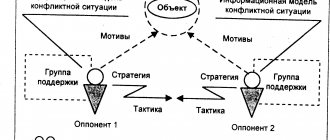Casual attribution is a phenomenon of perception of a person by a person, which consists in explaining, attributing the reasons for the actions of this very perceived person in the condition of a lack of information about the real reasons for such an action.
So, you come to work, and your colleague compliments you right from the door. You don't know the real reasons why he did this. And a variety of “explanations” may pop up in your head:
- “I had a fight with my girlfriend and now I’m ready to hit on me”;
- “I really put on my makeup today”;
- “He wants to suck up and go on vacation, dumping extra work on me.”
So, in everyday life, we come across examples of casual attribution. Surprisingly, in fact, a colleague may simply be in a good mood and ready to shower the whole world with compliments.
This concept was formed in Western social psychology, and is most fully revealed in the theory of attribution. The main questions that were revealed during the creation of this theory concerned the mechanisms and factors with the help of which an ordinary person explains, first of all, to himself the cause-and-effect relationships of the events in which he participates or witnesses, as well as how he explains his personal behavior .
Now the concept has expanded significantly. Casual attribution in psychology is the attribution of different motives and qualities to the person we encounter in life. Sometimes these “conclusions” of ours may be unconscious.
However, how do we explain to ourselves the behavior of a stranger if, as was said earlier, we do not know his real motives? Naturally, we ourselves have personal experience, on the basis of which we derive variants of existing motives. In addition, the society in which we live offers or even imposes familiar schemes for explanation.
So, while waiting for a late friend, we will catch ourselves wondering if something happened to her child, because for us at this stage of life, the most important thing is our baby. And we can only be late without calling if something bad happens to the baby.
But the blaring radio receiver, of course, will convince us that our friend is stuck in those very terrible traffic jams in the city center.
What is attribution
It all started with the desire of people to explain the motives for their own behavior and the behavior of other people. Very soon the term was expanded, as a result of which it was possible to go beyond the initial scope.
Attribution is the attribution of different psychological properties to a person based on observation of him. Even unconscious conclusions about someone can take place here, and the reasons for behavior can also be considered.
Now attribution is not just about determining the characteristics of someone's behavior. It represents a number of psychological characteristics that can be directed to other objects. In any case, attribution is the main mechanism of social perception.
Use of attribution in psychology
We use all the theories and psychological terms described above in real life. For example, “adding to” a story, a feeling of helplessness, a person’s image, self-criticism and criticism are a consequence of a certain type of attribution. So, here's the result.
Attribution is the process of inferring behavior or causes of events due to human curiosity or when trying to avoid uncomfortable and sometimes dangerous situations.
We tried to give the most complete definition and concept of the term attribution, to reveal its essence, types, features of use
Causal attribution
Causal attribution is a concept in psychology that arose from attempts to explain the motives of one’s own and others’ behavior. But soon the term was expanded. Modern psychology is aimed at identifying the causes of behavior, which is accompanied by the attribution of various kinds of characteristics.
Causal attribution is a concept in psychology introduced by psychologist F. Heider. Sometimes you need to predict someone's behavior, but there is not enough data for this. Therefore, the motives and qualities of a person are often guessed at. Also, characteristics of various kinds (not represented in the field of perception) can be attributed to a social community and group.
In addition, causal attribution is an example in psychology of explaining the actions, thoughts, and feelings of another person. Thus, there is a search for reasons that explain the behavior of the individual. Research has shown that each person prefers a range of causal schemas. That is, he explains other people's behavior, guided by familiar patterns. Additionally, each person has their own range of systems and options. There are also certain personal methods of causality that explain other people's behavior.
Causal attribution theories
The most popular are two of them.
Jones and Davis Correspondence Theory
Scientists Jones and Davis presented a theory in 1965 that suggested that people pay special attention to intentional behavior (as opposed to random or mindless behavior).
This theory helps to understand the process of internal attribution. Scientists believed that a person is prone to making this error when he perceives inconsistencies between motive and behavior. For example, he believes that if someone behaves friendly, then he is friendly.
Dispositional (i.e. internal) attributes provide us with information from which we can make predictions about a person's future behavior. Davis used the term "correspondent inference" to refer to the case when an observer thinks that a person's behavior is consistent with his personality.
So what leads us to draw a correspondent conclusion? Jones and Davis say that we use five sources of information:
- Choice
: When behavior is freely chosen, it is said to be driven by internal (dispositional) factors. - Random or intentional behavior
: Behavior that is intentional is more likely to be related to the person's personality, while random behavior is more likely to be related to the situation or external causes. - Social desirability
: You observe someone sitting on the floor, even though there are empty chairs. This behavior has low social desirability (nonconformity) and is likely to be consistent with the individual's personality. - Hedonic relevance
: when another person's behavior is directly intended to benefit or harm us. - Personalism
: When another person's behavior seems likely to affect us, we assume that it is "personal" and not simply a by-product of the situation in which we find ourselves.
Kelly covariance model
Kelly's (1967) covariance model is the most famous attribution theory. Kelly developed a logic model for assessing whether a particular action should be attributed to a characteristic (intrinsic) motive or to the environment (extrinsic factor).
The term covariance simply means that a person has information from multiple observations at different times and in different situations and can perceive covariance between the observed effect and its causes.
He argues that in trying to discover the causes of behavior, people act like scientists. In particular, they consider three types of evidence.
- Consensus
: the degree to which other people behave similarly in a similar situation. For example, Alexander smokes a cigarette when he goes to lunch with his friend. If his friend also smokes, his behavior has a high consensus. If only Alexander smokes, then he is low. - Distinctiveness
: The degree to which a person behaves similarly in similar situations. If Alexander smokes only when socializing with friends, his behavior is highly distinctive. If in any place and at any time, then it is low. - Consistency
: The extent to which a person behaves in a manner each time a situation occurs. If Alexander smokes only when socializing with friends, consistency is high. If only on special occasions, then it is low.
Let's look at an example to help understand this attribution theory. Our subject is Alexey. His behavior is laughter. Alexey laughs at a comedian’s stand-up performance with his friends.
- If everyone in the room laughs, consensus is high. If only Alexey, then low.
- If Alexey only laughs at the jokes of a particular comedian, the distinctiveness is high. If she is above everyone and everything, then she is low.
- If Alexey only laughs at the jokes of a particular comedian, consistency is high. If he rarely laughs at this comedian's jokes, she is low.
Now if:
- everyone laughs at this comedian’s jokes;
- and will not laugh at the jokes of the next comedian, given that they usually laugh;
then we are dealing with external attribution, that is, we assume that Alexei laughs because the comedian is very funny.
On the other hand, if Alexey is a person who:
- the only one who laughs at this comedian's jokes;
- laughs at the jokes of all comedians;
- always laughs at the jokes of a particular comedian;
then we are dealing with internal attribution, that is, we assume that Alexey is the kind of person who likes to laugh.
So there are people who attribute causation to correlation. That is, they see two situations following each other and therefore assume that one causes the other.
One problem, however, is that we may not have enough information to make such a decision. For example, if we don't know Alexey very well, we won't necessarily know for sure whether his behavior will be consistent over time. So what should you do?
According to Kelly, we go back to past experiences and:
- We repeatedly increase the number of necessary reasons
. For example, we see an athlete winning a marathon and we think that he must be a very strong athlete, train hard and be motivated. After all, all this is necessary to win. - Or we increase the number of sufficient reasons
. For example, we see that an athlete has failed a doping test and we assume that he was either trying to deceive everyone or accidentally took a prohibited substance. Or maybe he was completely deceived. One reason would be enough.
If your English level is above average, you can watch the following video, in which a teacher from Khan Academy explains the term “covariation” in simple words.
The need for attribution
The information that can be obtained through observation is insufficient. It is not enough for a person to fully interact with what is happening. Therefore, such information needs to be “completed”.
Everything happens to predict the actions of the individual of interest in the future. Attribution can be made by a team or an individual.
It can be difficult to understand someone's behavior. For this there is not enough sensitivity, knowledge in psychology or simply information. As a result, other people's behavior is subject to speculation.
Properties of the object of causal attribution. Correlation of properties of subject and object
The behavior of the object of causal attribution is considered by the subject, first of all, from the point of view of two main indicators: the degree of uniqueness or typicality of the act and the degree of its social “desirability” or “undesirability.” “Typical behavior is behavior prescribed by role models, and therefore it is easier to interpret unambiguously. On the contrary, unique behavior allows for many different interpretations and, therefore, gives scope for attributing its causes and characteristics... Socially “desirable” is understood as behavior that corresponds to social and cultural norms and is therefore relatively easily and unambiguously explained. When such norms are violated (socially “undesirable” behavior), the range of possible explanations expands” [3].
Thus, the emergence of the process of causal attribution itself depends on the object of causal attribution.
The properties of the object of causal attribution that determine the direction of the process include, first of all, external attractiveness . The mistake in interpreting attractiveness is that people tend to overestimate an outwardly pleasant person based on other psychological and social parameters that are important to them, but if he is unattractive, then his other qualities are underestimated. “The famous trial lawyer K. Darrow stated back in 1933 that juries rarely convict a person they like or acquit someone they don’t like... All this is of particular importance in situations where there are not enough specific facts relevant to the case to form an unambiguous opinion” [4].
Another important property of an object that influences causal attribution is the degree to which it “reveals” itself to the perception of other people. The pattern is manifested in the fact that more secretive people are perceived more negatively, and open ones - depending on the ratio of the properties of the subject and object of causal attribution.
“For the observed, the process of his perception by a communication partner appears as an action of self-presentation, which, depending on the goals of communication, can be sincere or controlled and manipulative” [3].
The ratio of the characteristics of the subject and object of causal attribution is of great importance. In the case of inequality , when the observer feels the superiority of the observed in some important parameter for him - intelligence, height, financial situation, etc., the observer evaluates the observed significantly higher in other significant parameters. If we are dealing with a person whom we are superior in some way, then we underestimate him. Moreover, superiority is recorded in one particular parameter, while overestimation (or underestimation) occurs in many parameters.
If are similar in some characteristics, especially if the observed shares important opinions of the observer, the mistake of the subject of causal attribution is that he is inclined to evaluate the object higher on other psychological indicators. The closer someone else’s opinion is to your own, the higher the assessment of the person who expressed this opinion. In the case of long-term relationships between the subject and the object of causal attribution, the similarity of characteristics acquires a triple force: “a number of experimental studies show that as long-term contact continues, the emerging bias towards the object of perception serves as a source of various kinds of distortions in the image of the perceived” [4].
The agreement or disagreement of the communication partner with the opinion of the interpreter is for the subject of causal attribution a sign of the object’s attitude towards him. It is known that people who treat us well are rated higher than those who treat us poorly. Therefore, the similarity factor acts with double force: not only similarity as such, but also similarity through the formation of relations between the subject and the object of causal attribution.
The mechanisms of influence of the relationship between the characteristics of the subject and the object of causal attribution operate thanks to the identification mechanism, which will be described in the next section (4.3.).
Next: Features of the situation
Types of attribution
People who have developed personal attribution are focused on finding the culprit of what happened. If you attribute the cause of a situation to a certain person, then personal attribution in psychology manifests itself. The examples are not complex: “We didn’t arrive on time because you missed the train.”
If a person has developed detailed attribution, he often blames external factors. He is not interested in searching for a specific person.
Stimulus attribution consists of blaming an object. The glass fell and broke as it was on the edge of the table. The reason may also be that the victim himself is to blame.
Casual attribution in psychology. Attribution Examples
This phenomenon exists because everyone wants to see the whole picture, to imagine all the events.
But the problem is that the facts are not always known. And then the person begins to finish drawing, to think out the picture, bringing it to a logical conclusion. This process is carried out in accordance with existing life experience. Psychology has noted the diverse reactions of society to stereotypical and deviant behaviors .
Let's look at an example. The students are waiting for a new teacher to teach them history. If you ask them to describe their history teacher, then most likely the classes will be boring and uninteresting. And if you introduce them to another teacher, having previously described his teaching style (he uses visual models, arranges skits, does everything to make the lessons interesting), then the opinion about the person will be non-standard, different from the common habitual judgment.
Errors of perception
The study of causal attribution has led to the identification of various patterns that lead to perceptual errors. It is noteworthy that people explain the success of strangers and personal failures using situational attribution. Usually we try to treat ourselves softer and more loyal than we treat strangers. But to analyze one’s own successes and the failures of others, personal attribution in psychology is used. This is a feature of the human psyche.
It is also interesting that the reason for success is usually associated with one’s own merits. But failures are blamed on circumstances. A person believes that he is successful because he is hardworking and smart. And his failure was solely due to external factors.
But if we are talking about another person, then attribution in the psychology of communication manifests itself in the opposite way. Example: he is lucky, he is a sneaky and sneaky person, this person’s relationship with the manager is not formal. Or his failures are associated with laziness, insufficient intelligence.
Goals and results of causal attribution research
The goal of research into the mechanisms of causal attribution is to increase the effectiveness of interaction between people and the effectiveness of personal growth. The first presupposes the most accurate determination of the motives of certain actions. And the second shows options for influencing motivation, activity, emotions, etc. What most fully helps to understand the study of this phenomenon is the indication of the moment of assigning or accepting responsibility for specific actions. And a comprehensive consideration of the current result. That is, the goal of research is to find an accurate definition of the actual motives of behavior .
Errors of perception
It is known that a person treats himself more softly when assessing than other strangers.
A person attributes someone’s successes and his own failures to situational attribution. But, describing other people's failures and his own successes, he turns to personal attribution. In these cases, a person tends to consider the cause of what happened to be either the prevailing circumstances or the person himself, according to the final result. Usually a person explains success by his hard work, willpower, and his uniqueness. But failure is always associated with the situation. And if you analyze the actions of another person, then all of the above applies in reverse order. If a person achieves success, it is because the circumstances have developed that way. And if he failed, then he himself is to blame . And few people think differently. Few will pay attention to the situation and focus on it. After all, if you explain the result of a person’s activity in a different way, then this means recognizing it at your level, or even better. This means comparing him to yourself.
Therefore, people tend to protect their self-esteem in this way. It is easier to blame the circumstances, the object of the action, than to force yourself to work, to improve yourself. Causal attribution is applicable everywhere: in everyday life, at work, in relationships. And this principle of opposites operates everywhere.
Attribution when evaluating subordinates
Conflicting attribution biases are typical in any organization. This mainly concerns different situations, namely, existing prejudices.
If managers are asked to talk about the reasons for the ineffectiveness of their subordinates, they mainly cite internal factors as the reasons. They consist of a lack of effort and ability. At the same time, they mention external factors, such as insufficient support, much less often. Thus, there is an overestimation of the influence of individual factors in the behavior of other people. These results indicate a tendency to underestimate the influence of situational factors and exaggerate the influence of individual factors.
Conclusion
It is very important to avoid causal attribution, especially when it ruins your life and leads to trouble. Stop your flow of thoughts for a moment and understand the reason for the behavior of a particular person - this is usually enough to avoid making sudden conclusions. This will improve your observation skills and teach you to empathize with others.
In addition, you should understand that there is no problem in attributing your failures to external factors, and your success to internal ones (especially if it is deserved). Just don’t make a blind habit out of it, but look at the situation.
We wish you good luck!
Did you like the article? Join our communities on social networks or our Telegram channel and don’t miss the release of new useful materials: TelegramVKontakteFacebook
We also recommend reading:
Rational thinking

Social perception

Causes of prejudice

Attribution: Correspondence Inference
Key words:1Cognitive science
Attribution for executives
If managers are asked to determine their ineffectiveness, then the majority chooses a lack of support, that is, an external situational factor. This is due to the tendency of bosses at various levels to deny their responsibility in the situation. This approach is also notable for taking responsibility for success. Attribution in psychology is a characteristic that manifests itself in managers’ assessment of their own performance.
There was an increase in their work efficiency with improved levels of support. They did not believe that their ability, as well as their desire to work hard, were significant factors. But in relation to subordinates they insisted on the importance of these aspects.
But people with a developed sense of empathy quickly understand the feelings of others. In addition, they tend to consider such behavior as their own.
That is, attribution is the inference of someone’s behavior in the absence of additional information. We all try to get as much insight as possible about the interlocutor or team based on some data. But when there is not enough of them, an attribution arises that may correspond to reality or contradict it. Points like these should be taken into account.
Causal attribution is the desire of people to find an explanation for what happens to them and around them. People need such explanations for various reasons.
- 1. When a person understands what is happening to him and around him, he is able to control what is happening and, to the extent possible, avoid unpleasant consequences and unforeseen events both for himself and for people close to him.
- 2. In this case, a person gets rid of the feeling of anxiety associated with a lack of understanding of what is happening.
- 3. Understanding what is happening allows a person to behave rationally in the current situation and choose a rational course of action.
For these reasons, a person seeks and finds for himself at least some explanation for what is happening. Even if this explanation ultimately turns out to be incorrect, it can still allow the person to solve at least one of the problems outlined above, for example, temporarily calm down and be able to solve the problem in a calm environment on a reasonable basis.
One of the variants of the theory of causal attribution was proposed by the American scientist F. Filler. It argues that one person's perception of the behavior of other people depends to a large extent on what that person perceives as the reasons for the behavior of the people he perceives.
It is assumed that there are two main types of causal attribution: interval (internal) and external (external). Internal causal attribution is the attribution of the causes of behavior to a person’s own psychological properties and characteristics, and external causal attribution is the attribution of the causes of a person’s behavior to external circumstances beyond his control. A person who is characterized by internal causal attribution, perceiving the behavior of other people, sees its reasons in their own psychology, and someone who is characterized by external causal attribution sees these reasons in the environment. Combined, internal-external attribution is also possible.
Modern attribution theory is a broader concept than causal attribution. It describes and explains all kinds of attributive processes, that is, the processes of attributing something to something or someone, for example, certain properties to some object.
The general attributive theory comes from F. Heider's idea of attribution. This theory assumes the following order of events.
- 1. A person observes how someone else behaves in a certain social situation.
- 2. From the results of his observation, a person draws a conclusion about the individual goals and intentions of the person he is observing based on the
perception and evaluation of his actions. - 3. The person attributes to the observed certain psychological properties that explain the observed behavior.
When finding or explaining the causes of certain events, people are guided by certain rules, make conclusions in accordance with them, and often make mistakes.
F. Heider, the author of another well-known theory of causal attribution (along with Fiedler), came to the conclusion that all possible explanations of people are divided into two options; explanations focusing on internal, psychological or subjective reasons, and explanations in which references to external circumstances beyond people's control predominate.
Another specialist in the theory and phenomenology of causal attribution, G. Kelly, identifies three main factors that influence a person’s choice of a method of internal or external explanation of what is happening. This is the constancy of behavior, its dependence on the situation and the similarity of a given person’s behavior with the behavior of other people.
Constancy of behavior means the consistency of a person's actions in the same situation. Situation dependence of behavior involves the idea that people behave differently in different situations. The similarity of a person's behavior to the behavior of other people implies that the person whose behavior is being explained behaves in the same way as other people behave.
The choice in favor of an internal or external explanation of behavior, according to Kelly, is made as follows:
- if a person concludes that a given individual behaves in the same way in the same situation, then this person attributes his behavior to the influence of the situation;
- if, as a result of observing the behavior of another individual, a person comes to the conclusion that in the same situation the behavior of the observed person changes, then he explains this behavior by internal reasons;
- if the observer states that in different situations the person he is assessing behaves differently, then he is inclined to conclude that the behavior of this person depends on the situation;
- if an observer sees that in different situations the behavior of the person he observes remains the same, then this is the basis for the conclusion that such behavior depends on the person himself;
- in the case when it is discovered that different people in the same situation behave in the same way, a conclusion is drawn in favor of the predominant influence of the situation on behavior;
- If an observer discovers that different people behave differently in the same situation, then this serves as a basis for attributing such behavior to the individual characteristics of people.
It has been established that when explaining or assessing the behavior of other people, we tend to underestimate the impact of the situation and overestimate the impact of a person’s personal characteristics. This phenomenon is called the fundamental attribution error. This error does not always appear, but only when the probability of attributing a cause to external or internal circumstances is approximately the same. Based on Kelly's concept described above, we can state that most often the fundamental attribution error will manifest itself in conditions where the person explaining the behavior cannot make a definite decision regarding the extent to which it is constant, depends on the situation and is similar. with the behavior of other people.
In the cause-and-effect explanation of one's own behavior and the behavior of other people, a person acts differently. In the same way, a person explains the behavior of those people whom he likes or dislikes in different ways. There are certain patterns at work here, which, in particular, can manifest themselves in the following:
- if a person has done a good deed, then he is inclined to explain it by his own merits, and not by the influence of the situation;
- if an action committed by a person is bad, then he, on the contrary, is more inclined to explain it by the influence of the situation, and not by his own shortcomings.
When a person has to explain the actions of other people, he usually acts as follows.
- 1. If a good deed was committed by a person who is unsympathetic to this individual, such an act is explained by the influence of the situation, and not by the personal merits of the person who committed it.
- 2. If a good deed was performed by a person whom this individual likes, then he will be inclined to explain it by the own merits of the person who committed the deed.
- 3. If a bad deed is committed by a person who is antipathetic to a given individual, then it is explained by the personal shortcomings of the person who committed it.
- 4. If a bad act was committed by a person who is liked by the individual evaluating him, then in this case the corresponding act is explained with reference to the current situation, and not to the shortcomings of the person who committed it.
Another common error in causal attribution is that when a person explains the reasons for something, he looks for and finds them exactly where he was looking for them. This refers to the fact that if a person is set in a certain way, then this mood will inevitably manifest itself in the way he will explain what is happening.
For example, if, observing a person’s behavior, we are initially determined to justify it, then we will definitely find appropriate justifications; if from the very beginning we are determined to condemn the same behavior, then we will certainly condemn it.
This is manifested in a characteristic way, for example, in legal proceedings, which since ancient times has been focused on the presence and exclusion of subjectivity in human judgments and assessments. The prosecutor, however, is always opposed to the defendant. He accordingly looks for and finds arguments aimed at condemning him. The defense attorney, on the contrary, is initially inclined in favor of the defendant, and accordingly, he always looks for and finds compelling arguments in order to acquit the same defendant. From a psychological point of view, this practice is of interest because the above-described errors of causal attribution are clearly manifested in the attitudes and actions of the prosecutor and defense attorney.
Attribution of ancient monuments. Attribution methods. Do attribution. Attribution is based on an analysis of style, plot, and the results of physical and chemical research.
Psychological. An attempt to understand the behavior of a person, a group of people, a social community in conditions of a lack of information through speculation; mechanism for explaining smb.'s reasons. behavior.
Social attribution. Personal attribution.
Encyclopedic information The theoretical and empirical study of attribution began with the works of F. Heider (1958), E. Jones, K. E. Davis (1965), H. Kelly (1967). The development of the concept of attribution began with identifying how people explain to themselves the motives of others and their own behavior (causal attribution). The modern concept of attribution covers the attribution of various mental properties to oneself and other people (personal characteristics, abilities), inferences (often unconscious) about the probable causes of their behavior and prediction of the likelihood of various actions and their results in the future. The most common concept is the “fundamental attribution error”, which consists in the tendency to attach greater importance to personal (dispositional) factors and ignore situational influences when describing people and their behavior, which can lead to incorrect, inadequate attributions. The term was introduced by L. Ross (1977). (T.V. Anisimova)
Often we try to understand the reasons for the actions of others. At the same time, the assessment of behavior can be associated both with circumstances and with the personal characteristics of a particular person. This assessment is called “causal attribution.” What is the theory of causal attribution is a question that requires detailed consideration.
Types of causal attribution
Wikipedia defines the term as follows: (from Latin causa - cause, Latin attributio - attribution) - a phenomenon of interpersonal perception. It consists of interpreting, attributing reasons for another person’s actions in conditions of a lack of information about the actual reasons for his actions.
Trying to find the reasons for other people's behavior, people often fall into the traps of prejudice and error. As Fritz Heider said: “Our perception of causality is often distorted by our needs and certain cognitive distortions.”
Here are examples of cognitive distortions due to causal attribution.
Fundamental attribution error
The fundamental attribution error is the explanation of other people’s actions by internal factors (“this person is a bore” – internal disposition), and one’s own actions by external circumstances (“events unfolded in such a way that I could not have done anything differently” – external disposition). It becomes most obvious when people explain and assume the behavior of others.
Reasons for fundamental attribution:
- Unequal opportunities: ignoring the characteristics determined by the role position.
- False agreement: viewing one's behavior as typical and behavior that differs from it as abnormal.
- More trust in facts than in judgments.
- Ignoring the informational value of what did not happen: what was not done should also be the basis for evaluating behavior.
Example one: your friend failed the exam that you both took. He always seemed to have a low level of knowledge. You begin to think that he is lazy, doing everything but studying. However, it is possible that he has problems remembering information or some difficult circumstances in the family that interfere with preparing for exams.
Example two: a stranger’s car won’t start. You decide to help him by giving him some practical advice. He disagrees with them or simply ignores them. You become angry and begin to perceive this person as rude and rejecting sincere help. However, he's probably been given the same advice before and it didn't work. After all, he just knows his car better. Or he was having a bad day.
Note that we are talking about internal disposition. If we talk about external ones, then if you do not pass the exam, then, most likely, you will explain this not by the low level of your knowledge, but by bad luck - you got the most difficult ticket. And if your car doesn’t start, then the person who is trying to help/being smart, even though he wasn’t asked, will be to blame.
External disposition is not necessarily bad. This is to some extent a defense mechanism because you don’t feel guilty, don’t spoil your mood and look at the world optimistically. But it can also lead to a constant search for excuses and personality degradation.
Cultural prejudice
It occurs when someone makes assumptions about a person's behavior based on their cultural practices, background, and beliefs. For example, people from Western countries are considered to be individualists, while Asians are collectivists. Well, you’ve probably heard more than one joke about Jews, Armenian radio and representatives of many other nationalities.
Difference between participant and observer
As already noted, we tend to attribute the behavior of other people to our dispositional factors, classifying our own actions as situational. Therefore, attribution may vary from person to person depending on their role as a participant or observer - if we are the main actor, we tend to view the situation differently than when we are simply observing from the outside.
Dispositional (characteristic) attribution
It is the tendency to attribute people's behavior to their dispositions, that is, to their personality, character, and abilities. For example, when a waiter treats his customer rudely, the customer may assume that he has a bad character. There is an instant reaction: “The waiter is a bad person.”
Thus, the customer succumbed to dispositional attribution, attributing the waiter's behavior directly to his personality, without considering the situational factors that could cause this rudeness.
Self-serving attribution
When a person receives a promotion, he believes that it is due to his abilities, skills and competence. And if he doesn’t get it, then he thinks that the boss doesn’t like him (an external, uncontrollable factor).
Initially, researchers thought that the person wanted to protect their self-esteem in this way. However, later it was believed that when results meet expectations, people tend to attribute this to internal factors.
Defensive attribution hypothesis
The defensive attribution hypothesis is a social psychological term that refers to a set of beliefs that a person holds in order to protect themselves from anxiety. To put it simply: “I am not the cause of my failure.”
Defensive attributions can also be made towards other people. Let's put it in the phrase: "Good things happen to good people, and bad things happen to bad people." We believe this so we don't feel vulnerable in situations where we have no control over them.
In this case, everything goes to the extreme. When a person hears that someone was killed in a car accident, he may assume that the driver was drunk or bought a license, but this will certainly never happen to him personally.
All of the above examples of causal attribution are very similar to the state of mental discomfort of a person caused by a collision in his mind of conflicting ideas: beliefs, ideas, emotional reactions and values. This theory was proposed by Leon Festinger. He formulates two hypotheses for this phenomenon:
- When a person experiences dissonance, he strives with all his might to reduce the degree of discrepancy between two attitudes in order to achieve consonance, that is, correspondence. This way he gets rid of discomfort.
- The person will avoid situations in which this discomfort may increase.
Since you got a D in the exam, why should you feel discomfort because you didn’t prepare at all, right? Not true. To understand this, let's talk about locus of control.
Causal attribution - types and errors
Causal attribution in psychology shows various patterns that lead to errors of perception. People can explain their own failures and the success of others using situational attribution.
Often we all try to treat ourselves more loyally and kindly than the people around us. To analyze your successes and the failures of others, personal attribution is used. An interesting fact is that the reason for success is often associated with one’s own merits, while failures can be blamed on circumstances. This is the peculiarity of the human psyche.
Types of causal attribution
When speaking about what causal attribution implies, it is important to remember its types. Psychologists call three types of causal attribution:
- Object causal attribution - a cause-and-effect relationship is attributed to the object to which the action is directed.
- Personal – attributed to the person who committed the act.
- Circumstantial - attributed to circumstances
Causal attribution errors
There are typical errors in causal attribution:
- The tendency to overestimate the role of personal factors and the ability to underestimate the influence of the situation and circumstances. This error is typical for those who can be called observers. When assessing the behavior of another person, you can often see a certain pattern. So, in case of failures, they say that someone did not try very hard, or that people do not have enough abilities. When the result of the activity is successful, we can say that they were lucky. If we are talking about self-attribution, then the opposite trend can be observed, since its main goal is to maintain positive self-esteem.
- The fallacy of false agreement - a person tends to interpret his own behavior as typical, which is characteristic of many people.
- The error of different possibilities of role behavior - different social roles may imply different behavior. For this reason, during attribution, the perceiver interprets the behavior of others according to their social roles.
- Ignoring the informational value of what did not happen is a tendency to take into account exclusively obvious facts.
Causal attribution in communication
To understand what the concept of causal attribution means, it is important to know when it occurs. It appears when unexpected obstacles arise on the path to joint activities - when difficulties and conflicts arise, or when interests and views collide. At the moment when all this happens, people apply causal attribution. In other words, we attribute the reasons for behavior to other people, and the more difficulties in interaction, the more seriously we approach the search for the reason.
An example of a causal attribution would be being late for a meeting with friends. Some of those waiting are sure that this may be due to the weather, another believes that a friend is late due to frivolity, and a third even doubts whether the late person was informed about the meeting place. So, all friends have different ideas about the reasons for being late: circumstances, characteristics and, the reason is in itself.
First, let's understand what causal attribution is. This phrase comes from the Latin words causa - reason and attribuo - I give, I endow. Those. As a result, we have a special phenomenon in the interpersonal perception of people, which consists in interpreting the actions of others, a subjective explanation of the reasons for their behavior in conditions of limited information. For example, when grandmothers at the entrance see a young girl coming out of the front door, they think that she is going on a date and that she is a flighty person. Their assumption stems from the lack of sufficient information about this girl.
The theory of causal attribution itself came to us from Western social psychology, where it was broadly formulated as Attribution
theory
by such scientists as Fritz Heider (creator), Harold Kelly, Edward Johnson, Daniel Gilbert, Lee Ross and others. The goal of the study was to trace the mechanisms of constructing cause-and-effect relationships by ordinary citizens, to see how they explain not only the events occurring around them, but also their own behavior.
The following mechanism of causal attribution helps us understand some important things about others: people, observing the behavior of another person, strive to find out for themselves the reasons for this behavior → limited information prompts people to formulate the probable reasons for the behavior of another person → the reasons for the behavior of another person, which people determine for themselves, influence their attitude towards this person. This explains such phenomena as, for example, why your neighbors look askance at you, why the teacher doesn’t like your child, why you are rude in public transport and many others! Moreover, Heider, while studying the “man on the street”, who is guided by common sense when explaining the behavior of other people, came to the conclusion that the opinion about a person (a good person - a bad person) automatically extends to all his behavior (does the right thing - does something bad). arrives). This is why it is so difficult for you to change the wrong opinion of some people around you!
Researcher G. Kelly identified three types of attribution:
- personal attribution - the reason is attributed to the person performing the action (the child ate the candy because he was ill-mannered);
- object attribution - the reason is attributed to the object to which the action is directed (the child ate candy because this candy contains many substances that are addictive in children);
- circumstantial attribution - the reason is attributed to circumstances (the child ate candy because lunch was a few hours ago).
An interesting fact is that participants in events more often use circumstantial attribution, and observers use personal attribution. This is called a fundamental error. So, for example, your child says that he was late for school because the road was very snowy/dug up/there was an angry dog, and the teacher may say that he was late because he is lazy/irresponsible/doesn’t want to study.
What determines the degree of attribution, the depth of attribution? It depends on two factors: compliance of actions with role expectations and cultural norms. Those. The more you fit existing stereotypes, the less you are credited with. Why should you attribute something to you if you behave predictably? After all, in this case there is no shortage of information about you.
I would like to finish this article with the following: any theory gives us food for thought. So,
- before judging another person, pay attention to the circumstances in which he finds himself;
- before making excuses, look deep into yourself, perhaps the reason lies not in your environment, but in yourself;
- not all nice people do nice things and not all unpleasant people do bad things;
- if you want to live an extraordinary life, demonstrate your bright individuality, keep in mind that you will become a victim of causal attribution, you cannot do anything about it, but forewarned is forearmed!
Harmony to you and your loved ones!
Causal attribution and interpersonal attraction
Interpersonal attraction in psychology refers to sympathy, affection and relationships between people. Each of us not only perceives those around us, but also forms our own attitude towards them. At the same time, it will be individual for everyone. This attraction affects the very phenomenon of causal attribution. In other words, when the attitude towards a person is positive, then both the explanation of the reasons for actions and behavior can be softer and more loyal. When a person is openly unlikable, the reasons for a person's actions can be mercilessly criticized.
Attribution
Attribution - in social psychology - a “real” cognitive process of understanding and explaining the behavior of other people and one’s own.
The essence of attribution is to endow people with qualities that cannot be the result of social perception, since they are not explicitly present in external behavior accessible to the observer, but are attributed (attributed) to them. Attribution is an attempt to interpret a social object, to understand its behavior in conditions of information deficiency through speculation. The simplest classification of attributions divides them into situational and dispositional, which does not completely coincide with another division: external and internal attributions.
Historically, the development of the concept of attribution began with attempts to explain how people explain to themselves the motives of others and their own behavior. The modern concept of attribution covers the attribution of various mental properties (personal characteristics, abilities) to people observed by a person (including himself), inferences (often unconscious) about the probable causes of their behavior and prediction of the likelihood of various actions and their results in the future. The object of attribution can be any other person, the subject himself, a group, or in general any person whose behavior we observe (from a laboratory rat to the president).
In fact, attribution refers to both the process and its result, and the latter can be either true or false. Harold Kelly formulated the normative-descriptive criteria that people typically use when solving attribution problems. He argued that people typically use their experiences of distinctiveness of behavior (how a given person would have behaved in different circumstances), consistency of behavior (how the same person had behaved in the same circumstances before), and unanimity (how other people would have acted in similar circumstances). ). In this case, the cause of behavior is attributed to those factors with which covariation is expected (the principle of covariation of causes and effects). Often a person does not have any information to evaluate distinctiveness, consistency and unanimity, and then he uses the discounting rule. It consists of discounting (reducing) the value of one or another explanatory cause by the magnitude of the influence of other potential causes.
In most cases, in the process of attribution, people resort to one of these practices and get results that are quite suitable for everyday life, however, a number of exceptions have been identified, typical cases of erroneous attributions. These include:
1) fundamental attribution error;
2) bias of the actor-observer (when explaining the same behavior, the actor is prone to situational attributions, and the observer - to dispositional ones);
3) the tendency of people, when explaining behavior (especially their own), to make dispositional attributions in case of success and to situational ones in case of failure;
4) overconfidence in predictions based on dispositions. In situations of uncertainty, attributions are largely determined by a person's beliefs and prejudices.









